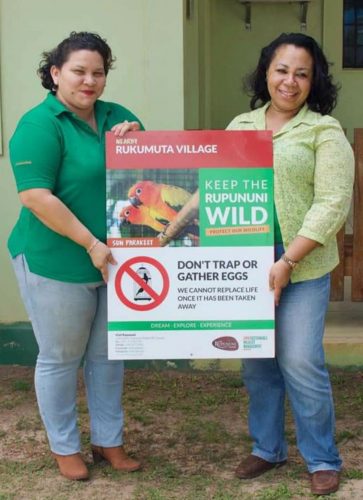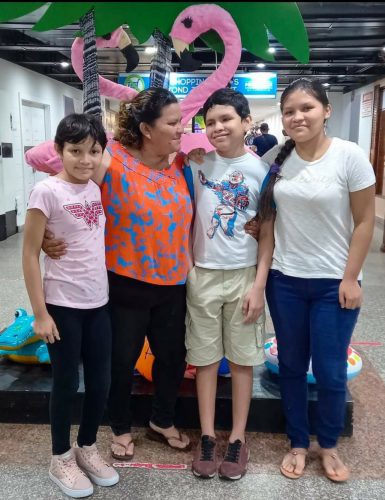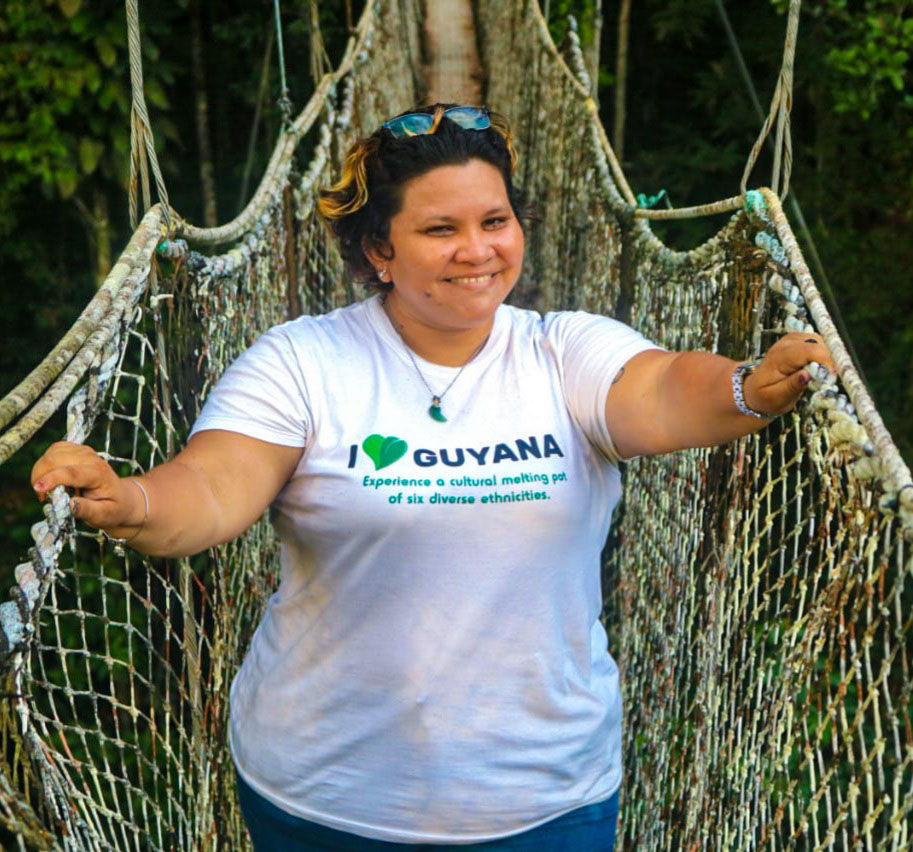Candace Phillips wears many hats. The product development manager at the Guyana Tourism Authority (GTA) is an advocate for tourism development, Indigenous peoples and women, and also a mother.
However, Phillips lives and breathes tourism, a field she wishes she had entered earlier on in life. “I love tourism to my core. I study it and try to understand every little thing about it. A few years ago, when I became enthused about tourism I actually said I want to be a minister of tourism. Now, I am sure that all I want is to take a leading role to help communities and to develop partnerships to push tourism development,” she told Stabroek Weekend in an interview.
Of Lokono (Arawak) origin, Phillips, 39, was born at the Kumaka District Hospital, Santa Rosa, Moruca but grew up in Georgetown from infancy.

“If you look at me, you would think that I would know how to do cassava work or row a canoe or know all the things about the Indigenous way of life. It is what people think and expect of me and it has given me perspective,” Phillips said.
She has to repeatedly explain that she grew up in the city and it was the only life she knew until she sought employment in sectors that would fill the gap she felt was missing in her life.
A past student of Bishops’ High School, she said she cannot deny that the school shaped much of her character. Initially, she wanted to be a corporate lawyer and she studied law at the University of Guyana. Her first job was a clerk with the law firm McKay and Moore.
After leaving the law firm, she joined the staff of the

Amerindian Peoples Association (APA) as a programme assistant and she enjoyed doing a lot of field work and everything under the moon, she said.
“At that time I hadn’t much understanding of the Indigenous way of life. My grandparents were still in Moruca. I would visit them now and then. I really loved the journey to Moruca but I always felt something was missing. There was part of me I had no knowledge about.”
When she saw the vacancy for a position at the APA advertised, she thought such a job would give her the opportunity to travel and to maybe to understand more about what she felt was missing.
Working with the APA exposed her to Indigenous communities countrywide. “I saw firsthand the struggles Indigenous Peoples faced with land rights, the impact of mining, deforestation, all the challenges that were present. That experience changed my outlook on life. At the time, the revision of the Amerindian Act was being talked about and [there was] so much lobbying to be done. I felt I needed to be part of it and I immersed myself in every place I went to understand the issues. Even though I was Indigenous in looks, all I knew was Georgetown.”
She began to learn in earnest and understand her role as an advocate for Indigenous rights. “I continued down that path. I was one of those persons who was involved in the start of the land tenure assessment which is now completed in all the regions.
“My path down road to corporate law took a U-turn.”
After she left full time employment, she continued doing part time work with the APA. During that period, she became a parent and stayed at home to focus on her young family.
Once the children were ready for school, she rejoined the workforce as a teacher and did a brief stint as a reporter with Stabroek News.
“However, as much as I liked writing, I could not continue because of the demands of the job. I opted to focus more on the demands of my family.
In 2012, she restarted working with the APA, lending project support.
In 2013, she made the bold move to relocate to Aishalton, Rupununi, where she lived for two years with her three young children to give them the exposure to some other place other than Georgetown.
“I still take them to different locations. I want them to not only understand and appreciate my work, but they must know their country.”
“As a woman and an Indigenous woman I work as hard as I do to represent women. We can have a family, be successful and be leaders in our right. As an Indigenous person I want to inspire the younger generations to let them know that being Indigenous does not stop them from being who they want to be. I am an Indigenous woman nearly at the top of my game because I work very hard to get where I am.”
The other driving force about being an Indigenous woman, she said, “As a mother, a single parent, I want my children to understand that you can be stronger and rebound even bigger than before.”
First tango
She went to the Rupununi with no expectations. “When I tell people I am from Region One, some of the Rupununi people say, ‘No, you are one of us.’ That tells how I fitted in, Even though I left two years ago, every time I return they tell me, ‘Welcome home.’ My only regret is, I do not have that connection with Santa Rosa.”
In 2014, while teaching at Aishalton Secondary School, Conservation International (CI) held a training workshop with the fifth form students on the basics of tourism and Phillips was the teacher assigned to accompany them.
“That was eye opening and my first tango with tourism. Before that, tourism was nowhere on my radar.”
Later on, CI, which has an office in Lethem, had a vacancy for a tourism coordinator. “I was encouraged to apply but I was sceptical. The terms of reference called for the establishment of a regional tourism body. I said there is no way I can do all of this. There was nothing like that in Guyana. To do something like that, you have to have not only management skills but to be successful in networking and have knowledge in marketing, park development and all the things intrinsic to tourism. There I was like a blank sheet.”
At the time, CI had a low carbon livelihood project aimed at alternative livelihoods and focusing on agriculture and tourism. The agricultural part was underway but there was no movement on the tourism aspect.
“I gave it my best shot on taking up the position. I moved from Aishalton to Lethem in July 2015. The CI family gave guidance every step of the way. The two international consultants who were to assist in mentoring me through the stages in setting up the body over a year left two months after I was on the job after plans went a bit awry. I had to absorb everything I could during that two-month period. I read, researched and tried to understand what was expected of me. I took time to connect with people.”
When she sent out emails about putting together the organisation, Visit Rupununi (VR), there was a lot of skepticism. “There were comments like, ‘We tried this before, it didn’t work. What makes this so different?’ Before VR, the Rupununi Tourism Association had tried to do the same thing.”
She recalled receiving an email from one of the managers of a lodge who said the idea of a regional body will never work and questioned why trying to reinvent the wheel when there was the national body, the Tourism and Hospitality Association of Guyana (THAG).
She used that email as motivation. “I knew I needed to do what I had to do to make it successful. I wanted to prove that person wrong. There was no one to tell me how to do it. It was to be the first regional body with no precedent and no local person with the experience. I was feeling my way in the dark. I had to lean on Google, try to find international examples, make sense of it and localize it.”
During her orientation she went around the Rupununi and met the owners of the properties. “It was disheartening because I am going with enthusiasm and there is someone telling me, he was not sure this thing was going to work.”
She focused in building relationships and showing the Rupununi stakeholders that if they work together in marketing and other areas to overcome challenges and to effect changes, they would benefit much more than if they do everything as individuals.
“When I look back I see a stronger united Visit Rupununi that can articulate on any issue they are experiencing. It is an organisation that considers everyone who is part of the tourism value chain if you are looking at destination development. Not only the accommodation providers but the single transportation provider, the craftsman, farmers and even the Regional Democratic Council (RDC).”
In 2017, VR received an award from THAG for the work it was doing.
“It was a crowning and defining moment for me. It represented the hard work and dedication I had put into its establishment as a regional destination management organisation that brings together stakeholders with strong link to the Ministry of Tourism, THAG, and other regional and national actors. As a proud parent, I look at Visit Rupununi as something that can outlive me.”
Phillips also represented the tourism sector at meetings of the RDC where she pushed for a stronger relationship between the RDC and VR.
In January 2019 she left CI to work with the RDC as an administrative assistant with responsibility for tourism, a position created for her. The RDC was seeking government’s support for VR, which Phillips noted is not a money making agency.
“It could do with Central Government’s support whether it is through a subvention or something like that to keep it afloat. We were pushing for the Ministry of Finance to recognise that tourism needs an allocation in the budget in the same manner as health, education, public works, agriculture among others. Tourism is a subcommittee that receives no subvention. So even if the RDC wanted to be more involved in tourism and understand more of it, there is no budgetary allocation for that. Tourism is not a desk job.”
The support for regional tourism development is often put on the backburner, she said. “Words and actions need to align. I look back on 2019 in which Guyana received so many accolades and was highlighted as an eco-destination. However, one of the complaints about domestic tourism is the cost of travelling. Our disposable income does not allow us to travel. If only we can make it more affordable.”
Phillips says that Rupununi is the most developed tourism circuit in Guyana, stretching from Iwokrama to South Rupununi and includes the river lodge, Turtle Mountain, many rare species of birds and animals, and several community lodges including at Surama, Rewa, Annai. It includes a list attractions including ranches, waterfalls and petroglyphs on rocks and up and coming destinations like Karasabai, home to the sun parakeet.
“A hospitable, welcoming people and giving back to the communities are at the heart of Rupununi Tourism,” she said.
In July 2019, after spending six years in the Rupununi, she returned to Georgetown to accommodate her daughter who received a government scholarship to a secondary school in the city based on her performance at the National Grade Six Assessment.
Developing new tourism products
On her return to the city, Phillips took on the post of travel industry development officer at the Guyana Tourism Authority.
“One of the first communities I worked with was Moraikobai in Region Five. Last year they commissioned their guest house and other offers. It was a good experience to lead them through that process.”
In March 2021 she was appointed the manager of product development. “It was a very proud moment in my professional career. I have to oversee a team that has to churn out new experiences to give to tour operators and partners for marketing.”
Over the past two years she has worked with several communities and the private sector to develop new products for the tourism market.
In spite of the COVID-19 pandemic, at the end of 2021, the GTA, for the first time under her guidance, launched seven products on the tourism market. These offers are at Warapoka, Santa/Aratak, St Cuthbert’s Mission, Taste of Freedom Tour with Singing Chef Adventures, Canje Sunset Tour and Fort Nassau Tour with Blackwater Adventures.
“In all the work with communities,” she said, “I draw from the early experience of working with the APA, having that understanding of working with Indigenous communities, understanding how to engage, how to guide, train Indigenous Peoples and not impose on them your ideas but seeing yourself as partners in the development process.”





